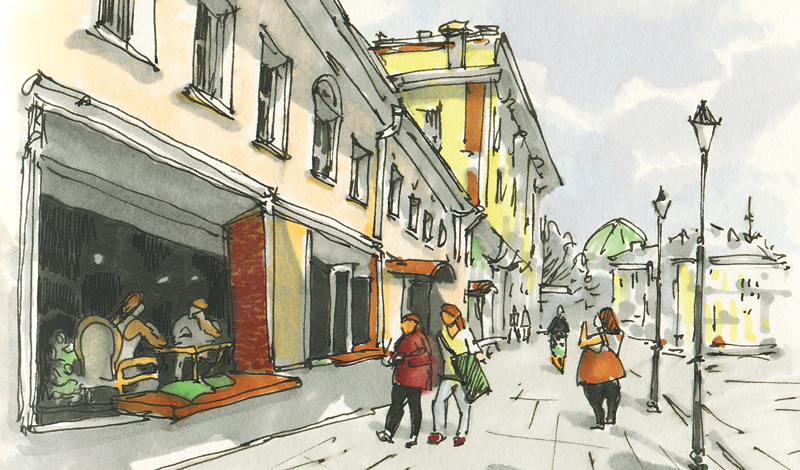World Tribune: Thank you for your time. Building community and fostering successors are key themes for the SGI-USA. Speaking to a member who joined in the ’70s as a student, he remarked that, even though as a generation they rebelled, they did it together. Today, the youth tend to live more solitary existences. What are your thoughts about building community in this context?

Amelia Gonzalez Tesch (SGI-USA young women’s leader): This generation experienced the pandemic during the years when they could have been spending time with their friends. I imagine they really want connection and friendship. Maybe on our part, it just takes more effort to build trust and find ways to meet them where they’re at.
My neighbor, who is 22 years old, said most of his friendships are online. When my husband and I invite him over for dinner or meet him in passing, he’s always so kind and happy to hang out. I think it’s less about them not wanting to connect and more about how we can lower the barrier and take the initiative to do so.

Kenichi Hackman (SoCal-Pacific Territory young men’s leader): I agree. I think we need a subtle but clear shift in our mindset. I used to think that people my age were closed off and preferred isolation. But actually, I was the one closed off and lacking life force.
Now, I look at strangers as “friends in the making.” This February, I moved into a new place. Our building has people of all generations, and there are lots of people walking their dogs in the neighborhood. Everyone’s so sweet and kind, and there are so many opportunities to spark conversations.
WT: Generation Z (those born between 1997–2012) are called the first “digital natives.” Many of those in college today have had their lives documented on social media. What does community look like for youth who have grown up in this environment?
Amelia: Well, some have a community online that can feel just as real as a physical one. Of course, getting stuck online cuts us off from important face-to-face interactions that help us grow and develop. Again, it’s all the more reason that we go to them.
Kenichi: It’s true. At the same time, I’m learning from some students in Southern California starting up SGI campus clubs. Younger members in those areas are really blossoming. I asked them what they do to bring people out. It’s nothing extraordinary—they chant and study together, and afterward they grab food, coffee, go bowling, you name it. They’re creating their own community—in person, face-to-face—and that’s encouraging. We just have to support and empower them.
WT: One recent study published by the Journal of Personality and Social Psychology suggests that positive relationships, social support and social acceptance help shape the development of self-esteem in people across their lives.[1]
How can we, as a Soka community, be that presence for young people?
Amelia: First step—get to know them! Every young person is different. Even though they’re growing up at the same time, it doesn’t mean they’re inspired by the same things. What’s important is connecting one-to-one and finding out what they’re interested in.
When there’s trust, they’ll open up and share what’s in their hearts. Then, we can support them in the best way. This really goes for anyone. Ikeda Sensei often mentions how important it is to treasure each individual.
Also, I recently heard a Today Show interview where the U.S. Surgeon General said that when we reach out and offer support to others, we build our self-esteem. I believe that as we join young people with meeting others or helping them encourage their friends, they’ll experience great joy. They will see that to bring happiness to another person is to create happiness for yourself.
Kenichi: I agree with Amelia. With the internet, young people today know so much and are exposed to so many things. Along those lines, I feel it’s impossible to meet youth where they’re at without getting to know them first.
On this summer’s SGI Youth Training Course, we heard an experience of a teacher whose student stopped coming to class. He tried to visit the student, but he was turned down again and again. Knowing the young man was interested in video games, he taught himself how to play and was finally able to connect over a game. Through this, he learned about the young man’s struggles and why he was missing class.
Racking our brains while chanting to find creative ways to engage is so crucial. But once there’s trust, it will become easier to connect them to the practice.
WT: This reminds us of a question that was posed to SGI Vice President Yoshiki Tanigawa when he visited Philadelphia in September: How can we attract more youth to our Soka community in a way where we could both maintain our organizational structure and encourage young people to be creative and take initiative?[2] His response in a nutshell was that creating something attractive may bring out youth, but they can just as easily disappear. He said what’s important is to pinpoint a person’s real struggles and to patiently engage them in developing their faith. What are your thoughts on this?
Amelia: Yes, totally agree! We shouldn’t assume that young people feel or think the same. We have to support each of them step by step, starting with wherever they are.
Kenichi: No matter what our meetings or activities may look like in the future, home visits and small group dialogues will always be a key part of our movement. How else can we really get to know someone, if not life-to-life?
WT: One key focus now is to assign men’s and women’s leaders to home visit and do gongyo with youth leaders to help them solidify a consistent rhythm of practice. Why is this important now?
Amelia: Without a consistent rhythm of morning and evening gongyo and daimoku, we won’t have the life condition to challenge our reality. The basics are so important if we wish to lead the kosen-rufu movement. In my own experience, many women’s leaders visited me in the morning to help me strengthen my morning gongyo. And by observing my seniors in faith on visits asking members if they chant consistently, I realized this is the foundation of my life. With a consistent practice, I can overcome anything.
Kenichi: Without a lot of daimoku, it’s so easy for me to feel overwhelmed. Second Soka Gakkai President Josei Toda called the Gohonzon a “happiness manufacturing machine.”[3] To me, it’s also a doubt-crushing machine!
The power of prayer really is unfathomable and hard to explain, and it can still be theoretical for young people. But when talking with those with a little more life experience—like our men’s and women’s leaders—we can learn from their actual proof of the practice and of applying Sensei’s guidance.
WT: Both of you have parents that practice, so you were raised in the “Garden of Soka.” There must have been times when you would have rather been left alone. What encouraged you to stick around?
Amelia: In those times, it was a women’s leader who I felt I could open up to, and I wouldn’t be judged. She would patiently listen to me (sometimes for hours) and encourage me to go back to the Gohonzon and Sensei, and use my SGI activities to overcome whatever I was going through. Having a senior in faith I could pour my heart out to without any judgment is definitely a reason I can continue.
Kenichi: In college, there was a men’s leader who lived nearby. Every month, he would hit me up and ask to get together. Every month I said, “Yes” and almost every month I flaked on him. But he never stopped trying. When we did get together, rather than lecturing me for all the times I flaked on him, he just seemed so happy to see me alive. I’ve never forgotten how much effort he put into someone who really didn’t give anything back.
WT: Any parting thoughts?
Amelia: I think it’s important to respect and cherish each youth. It’s only through getting to know each person that it becomes more clear how best to support them. I am determined to be someone who can listen to and learn something from each person I encounter.
Kenichi: Nichiren Daishonin wrote, “Could there ever be a more wonderful story than your own?”[4] I am also determined to challenge my human revolution, to become a person who can truly support the younger generations and help them see their incredible mission.
November 8, 2024, World Tribune, pp. 6–7
You are reading {{ meterCount }} of {{ meterMax }} free premium articles

